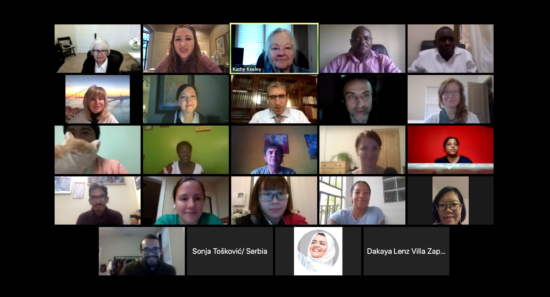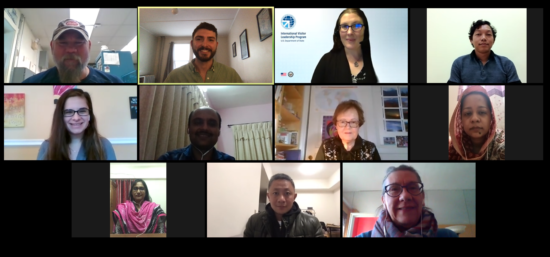Compiled by Christian Caudill, Senior Associate, Communications, Global Ties U.S.
Editor’s Note: Exchange programmers from our Community-Based Members share the challenges and rewards of hosting virtual International Visitor Leadership Program (IVLP) projects.
As we approached virtual programming at the Council for International Visitors to Iowa City (CIVIC), our biggest concern was not that we couldn’t do it; not that we wouldn’t be able to find the resources or be able to work the technology. It was that we are a small CBM which had experienced a series of leadership changes over a period of months. We knew we were solid, but would NPAs trust us with programming?
After networking directly with NPA contacts and Global Ties U.S. to secure projects, we hosted our first three virtual programs in late October. The technology worked. The interpretation worked. All our resources showed up, save one, who fell ill. It turns out that one of the advantages of virtual programming is that we were able to recruit a replacement panel within an hour– and all they had to do was turn on their computers.
Our lesson learned? Persist. And the lessons we would urge on the Network? Give everyone a chance. We’ve produced excellent programming for in-person programs. There is no reason in the world that we won’t do the same in the virtual setting.
–Janice Weiner, Executive Director

A multi-regional virtual IVLP group meets with Kathy Keeley (top center) of the Georgia Center for Nonprofits. Photo provided by Emily Shaw.
Georgia Council of International Visitors (GCIV) has had a fun and interesting adventure figuring out the new world of virtual exchange while hosting nine IVLP projects over the last couple of months. One of the biggest worries we had when starting with virtual exchange was the interest of our professional resources. Fortunately, we have found that most of them have been very interested and excited about meeting virtually and adaptable to the change.
One beautiful part about virtual exchange is that we are able to share our resources with not only the visitors, but also with the National Programming Agencies (NPAs) and the U.S. Department of State—something that is rarely an opportunity with in-person exchanges.
We have overcome our fair share of technical issues in virtual programming. Most memorably, when Atlanta was hit with hurricane Zeta, causing widespread power outages throughout the city, the program team at CRDF Global was able to seamlessly step in and help moderate when we lost our connection. Without having communicated this potential issue and shared the meeting materials with CRDF ahead of time, it would not have gone as smoothly. Our advice to anyone doing virtual programming would be to keep the lines of communication open and send any meeting materials to the NPAs, and vice versa, just in case!
Although we miss the personal connection and experience of in-person programming, we have enjoyed connecting virtual in the meantime. We have also truly enjoyed getting to know and connecting with the NPA programmers through this experience.
–Emily Shaw, Executive Director, and Sara Weigle, Program Coordinator
The Pacific & Asian Affairs Council (PAAC) held its first-ever virtual IVLP projects in October, connecting 31 visitors from 11 Pacific Island Nations with their Hawaii-based professional counterparts in the fields of youth empowerment and public health. Our “Young Pacific Leaders” group enjoyed a relaxed hour of discussion with representatives from Kupu, a local youth-focused nonprofit, while our “Public Health Leadership” group shared best practices with the State of Hawaii Department of Health personnel overseeing COVID-19 contact tracing efforts.
I was about skeptical whether the virtual meeting format would facilitate the same genuine connection between resources and visitors as in-person meetings as glowing screens, time zones, and the thousands of miles separating our parties might make the conversation feel unnatural or awkward or be interrupted by tech issues beyond our control (it is 2020, after all). To my relief, both meetings flowed smoothly with all participants responding positively to what was still, at the end of the day, a truly unique opportunity for them.
Some of our visitors did experience connectivity issues, which our NPA and I/L colleagues were quick to address and assist them with. I had not anticipated the convenience of the Zoom “chat” function, which allowed our visitors that were unable to attend via video to submit comments and questions for our guest speakers.
–Erin Hoshibata, Grant Proposal Writer and IVLP Program Coordinator
As Tulsa Global Alliance (TGA) prepared to host our first virtual IVLP projects this fall, we worried whether professional resources and host families would participate in virtual programs. Luckily, Oklahoma’s resources were missing international engagement and eager to explore virtual exchanges. Another worry was whether local resources were familiar enough with technology to participate virtually, and if we had anticipated and worked through enough solutions for potential issues. NPAs generously offered extra coaching, trial runs, and rehearsals, which made the program much easier. In our efforts to engage IVLP participants, we prepared questions in advance for resources to stimulate conversations.
We were pleasantly surprised to see the wonderful resources of other CBMs such as Global Minnesota, World Affairs Council of Seattle, World Trade Center Institute in Baltimore, Global Ties Miami, and San Diego Diplomacy Council when we joined in multi-city panel discussions with international visitors. This is impossible to do in-person and showed us work being done around the country.
In-person programming can present many challenges – switching meeting dates, replacing cancelled speakers – so having multiple back-up plans and a flexible outlook helps overcome them. We found that virtual programs were equally stimulating and even allowed us the chance to get creative and reach out to resources outside our immediate geographic region. It was wonderful feeling the excitement of programming and anticipation of new international visitors again.
–Bob Lieser, Vice President of Programming, and Cathy Smythe, Board Member

IVLP participants learning about energy policy meet with Jon Clarck (top left), a Burlington Electric Power Production Technician. Photo provided by James Gunger.
Our previous experience producing the Vermont Council on World Affairs’ (VCWA) Engage the World 2020 virtual conference helped us prepare to host virtual IVLP groups. Over the course of four days, we successfully hosted nearly 25 virtual events—from interviews to dance classes. The skills and lessons we learned preparing for and running the conference proved transferable and I felt more confident implementing virtual IVLP programming.
A benefit of virtual programming is our expanded ability to reach all corners of the Green Mountain State. The convenience of arranging programming without the restrictions of geographic boundaries enables us to engage and connect our visitors to new resources.
While the pivot to virtual programming brought new ways to connect, it also brought many unknowns. The uncertainty was a challenge, but also an opportunity for programmers to come together, collaborate as a network, and find our best path forward.
The resiliency of this Network is unparalleled. Witnessing our collective commitment to citizen diplomacy and international exchange has been incredible during this undoubtedly difficult year. Prior to the IVLP virtual transition, VCWA only set up Zoom calls on the rare occasion that a snowstorm prevented a group from safely travelling on the highway. Now, we are pleased to say that it is second nature.
–James Gunger, Program Manager
